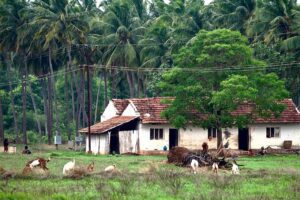Title: “How Indian Lifestyle Impacts Health: Insights by Arvindsinh Rana
Introduction:
“Have you ever wondered why we fall ill and what lies behind the causes of our ailments? Understanding the reasons behind our health issues can often be straightforward when we delve into them.One significant factor behind our health problems is our lifestyle, which has been substantiated through various scientific experiments.
Let’s explore a lifestyle that promotes good health and particularly focuses on the Indian way of life:

How Lifestyle Evolves:
Lifestyle of Middle East

Where we choose to reside plays a profound role in our lifestyle, as it significantly influences our well-being. The environment, resources available, and how we adapt to our surroundings all have a substantial impact on our lifestyle. In simple terms, “as the surroundings, so the lifestyle,” which naturally evolves.For instance, in arid countries with limited water resources, there’s a scarcity of water. This scarcity affects not only forests but also agriculture. Moreover, the increased heat due to a lack of vegetation leads to sun exposure, necessitating protection from harsh sunlight. The scarcity of resources requires efficient resource management for survival.
European Lifestyle

On the other hand, European countries with abundant snowfall experience more significant cold spells. It becomes essential to prepare for the winter months by creating food reserves and warm clothing. In such regions, people have learned to cultivate and store food to sustain themselves throughout the year. This preparation becomes crucial as it’s challenging to engage in outdoor activities during extended periods of snow and minimal sunlight.
During the periods when sunlight is scarce due to heavy snowfall, daily activities outside the home become challenging. The need to wear heavy coats for warmth further reduces exposure to direct sunlight, leading to insufficient vitamin D intake. This deficiency can result in various physical and mental health issues.
In such circumstances, it becomes challenging for people to go outdoors and engage in daily activities, even for a short period. Wearing minimal clothing to maximize sun exposure is often not an option. This leads to a lack of vitamin D, which is essential for overall health.In contrast, when the sun shines regularly and snow is absent, life becomes more accessible. The removal of snow blankets, flowing rivers, and flourishing fields allows people to engage in outdoor activities.
Simultaneously, it becomes imperative to maintain adequate levels of vitamin D throughout the year. This necessitates wearing minimal clothing to facilitate the absorption of sunlight.In regions where the majority of the population has adapted to the natural environment, this has become a way of life.
These populations have learned to harness and adapt to the natural resources and climate to create a lifestyle that suits them best.However, what’s noteworthy is that many of our ancestors underwent a long struggle with nature to develop lifestyles that are harmonious with their surroundings. They made mistakes and learned from trial and error.”Nature and a lengthy struggle with it are the origins of the lifestyle that we have today.
The Indian Lifestyle

“Now, let’s shift our focus to the Indian subcontinent. Our ancestors settled here for numerous reasons, and understanding some of these can provide valuable insights.- The Indian subcontinent receives the most significant rainfall on Earth, which has led to the development of diverse and fertile regions.- A substantial part of the region experiences three distinct seasons – summer, monsoon, and winter – creating a balanced cycle.- The abundant rainfall and ample sunlight in most parts of the region offer an ideal environment for agriculture, resulting in a rich bounty of grains and fruits.-
The varied topography includes fertile plains, dense forests, long coastal areas and vast desert areas. Mountainous regions are abundant as well.The regions with ample rainfall, rivers, and sunlight are ideal for agriculture, ensuring a constant supply of grains and fruits. However, this doesn’t negate the need for hard work in farming, as it’s crucial to manage resources efficiently to ensure food and sustenance.
It’s essential to note that our ancestors, for thousands of years, have been shaping their (Indian) lifestyles based on these factors. The people have adapted to their natural surroundings, cultivating a lifestyle that’s conducive to their well-being.
In conclusion, it’s clear that our lifestyles are deeply intertwined with the environments we inhabit. Nature has been a guiding force in shaping our way of life, and our ancestors have learned to adapt and thrive within these natural confines.
Latest Posts
- These 5 Reasons makes you Angry | How to Deal with it! | 8 Tips for Anger Management
- You must try this Magical Supplement for Mental Well-Being: (Anxiety-Depression-Sleep issues)
- What is the Relation Between Stress and Diabetes! – “Simplifying the connection”
- Benefits of Alkaline Water | Kangen Water
- Mental Health Awareness: 6 Practical Tips for Good Mental Health





1 Response
[…] Indian Lifestyle: Necessity or Choice? The Ultimate Exploration : By Arvindsinh Rana […]